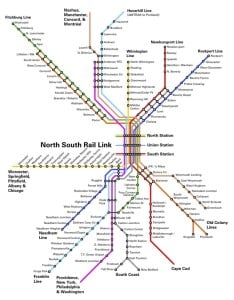Editor’s Note: Due to reader response, an editorial was written two weeks after this article ran. The discussion continues here.
It’s time again for the annual Turkey Awards, where we give a proper roasting to half-baked projects and development schemes. And do I have a doozy this year!
You would have thought that after the fiasco of the Big Dig we were all done with multibillion-dollar schemes that involve tunneling underneath downtown Boston. Apparently not, as the Baker Administration’s plans to spend $1.5 million to study the proposed raise the prospect of Big Dig II.
Now I have to say boosters of the 1.5 mile tunnel that would connect North and South stations have already notched a remarkable accomplishment: They’ve managed to dramatically shrink the cost of the project from $8 billion all the way down to $2 billion!
It’s like the reverse of the Big Dig, with super supporters like Rep. Seth Moulton citing the wonderful leaps in tunneling technology that will make boring a new rail tunnel under downtown Boston as easy as slicing cake.
Kind of amazing – until you realize the shrinking costs are not the result of any serious planning but rather estimates cranked out in hopes of selling this massive boondoggle in the making.
That anyone would take seriously the $2 billion estimate – courtesy of Moulton – is disturbing in and of itself, with major projects in Boston notorious for their overruns and with construction costs in general rising at a torrid pace. Not mentioned the mess in Seattle, where a tunnel boring machine broke down and caused a two-year delay that required digging a separate tunnel to get to the giant machine and repair it.
Money From The Sky
Beyond the prospect of another Big Dig style overrun, the money for the North-South Rail Link isn’t going to fall out of the sky and it certainly isn’t going to come from Washington, as it did during the days when Democrats controlled Congress.
None of that will deter North-South Rail Link supporters who, led by former Gov. Michael Dukakis, long ago drank the Kool-Aid.
North and South stations are already connected by Boston’s subway system, which, while hardly the height of efficiency, generally does the trick. Connecting the two stations by commuter rail would definitely eliminate a significant commuter hassle, reducing the 20 minute or so subway ride between the two stations to a five-minute rail ride.
But at what cost? In order to pay for this engineering marvel, we will have to rob the already struggling commuter rail and subway lines.
In fact, ridership on the MBTA has been dropping, particular on the commuter rail, which managed to be the only system in the country to shed riders from 2003 to 2013, according to the Pioneer Institute. And the numbers have continued to fall.
Why? Well, if you have ever ridden the commuter rail, you know exactly why. Trains are routinely late and if there’s a little snow or cold weather, don’t show up at all. To top it all off, ticket prices have gone up to the point where driving isn’t necessarily the most expensive option.
If you can’t get commuters to get on the train in the first place in Beverly and Salem, a multibillion-dollar tunnel connecting North and South stations is beside the point.
Meanwhile, commuters aren’t dummies.
The masterminds who run the MBTA apparently don’t realize it can be a major mess to show up late at work on a regular basis or even lose half a day of work – or more, as happened during the system’s epic meltdown during the record-breaking snowfall of 2015.
But the rest of the world, which toils for a boss less forgiving than state government, has already moved on. They’ve already learned the hard way that you can’t rely on the commuter rail – or the T trains or buses – and are investing their hard-earned transportation dollars elsewhere, whether it is on private bus companies and shuttles, carpooling or ride sharing to get to where they need to be.
The only way to recapture riders – and make a massive investment in another, expensive tunnel underneath downtown Boston – would be to dramatically boost the performance of the commuter rail system overall while lowering the price.
And barring unforeseen, miraculous circumstances, neither is happening in the lifetime of anyone reading this piece.
As you have figured out now, the downtown Boston rail tunnel is my favorite turkey this year – it was just too juicy and perfectly cooked to pass up.
Bon appetit!




 |
| 





